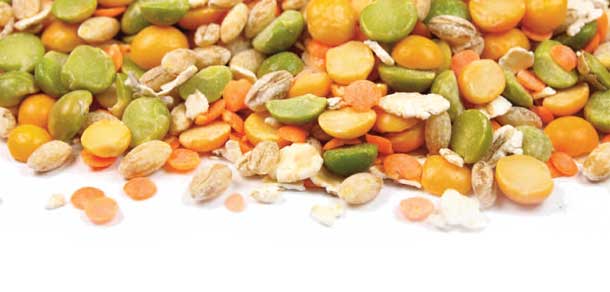Protein Industries Canada Delivers Lucrative Innovation
When Protein Industries Canada (PIC) was selected as one of the new federal research superclusters in early 2018, few people had yet heard of Beyond Meat. When PIC’s proponents talked about a growing global trend towards plant-based proteins, some might have thought they were a little crazy.
Meghan Gervais, P.Eng.
But Meghan Gervais, P.Eng. was not one of those people. With a long history in food processing and biotechnology, Gervais jumped at the chance to join the supercluster’s senior staff this summer.
Today, Gervais is PIC’s Intellectual Property Manager, helping to support PIC’s mission to inspire innovation and support collaboration to transform Canada’s agriculture and food processing sectors.
A Gathering of Minds, Not Offices
A common misconception about the supercluster concept is that they are huge research centres that gather together many scientists. In fact, aside from administration offices, the supercluster doesn’t occupy significant physical space.
“Our job is to bring people together, including researchers, entrepreneurs, large companies and others. We help break down silos and industry-wide barriers to build better value-chains,” Gervais said.
The organization is focused on cooperative technology development and requires all project consortiums to include a commercialization component. The goal of the supercluster is to challenge Canadian businesses to collaborate with other businesses, and post-secondary and research institutions to create projects that have the potential to transform the food processing sector in Canada, creating jobs and stimulating local economies.
The Opportunity
Western Canada and agriculture are practically synonymous terms. According to PIC, the region has more than 28 million hectares of arable land, accounting for more than 85 per cent of Canada’s production base.
This capacity for food production will be desperately needed in the coming years, according to Gervais.
“By 2050, global food demand is expected to rise by 70 per cent on the back of three billion more middle-class consumers – mostly in Asia – whose diets are shifting to include more protein. Think about it this way: the world will need to produce as much food in the next 45 years as in the previous 10,000 years,” Gervais says.
And then there are all those consumer trends that PIC predicted. The word “flexitarian” – mostly vegetarian but not obsessive – had not even been coined in early 2018 but today is an increasingly common diet choice. Hardly a month goes by without another chain restaurant launching a plant-based meat substitute product. As well, PIC’s projects help to meet growing demand for high protein but lower cost products for livestock feed, pet food and aquaculture.
According to PIC’s five-year strategy, the global plant-based protein market is expected to nearly double in the next five years, growing from an estimated $8 billion US today to $14.8 billion US by 2023.
PIC Your Project
PIC administers a $150 million fund to co-invest in projects that cut across four main focus categories.
Create – Projects that focus on advanced breeding technologies and germplasm development.
Grow – Projects that concentrate on primary production and sustainability, including technologies such as data and predictive analytics, artificial intelligence, automation and sensor technology.
Make – The Holy Grail of Western Canadian agriculture: value-added processing. These projects centre on improving current processes, developing new technologies or developing entirely new products from existing commodities.
Sell – These projects focus on developing new markets for human, livestock, aquaculture and pet food products.
According to Gervais, 16 projects were invited to full proposal from 38 applicants to the first round of expressions of interest. The second round that closed in September has seen similar levels of interest.
She notes that, from the first round, 17 per cent are in the Create category, 11 per cent in Grow, three per cent are in Sell but a whopping 69 per cent are in the Make category.
“Seeing that overwhelming interest in value-added production really speaks to our mandate of putting processing closer to production. It shows what a strong desire there is for those enterprises in Western Canada,” Gervais says.
Managing the Value of Ideas
At present, Gervais is the only engineer working at PIC. She holds two roles with the organization. First and foremost, she is the Intellectual Property (IP) Manager, a role that brings her into contact with every project under PIC’s wing.
“All projects must have an IP strategy. That’s to ensure that there is value for Canada, that we are creating products with economic value that will accrue here. Some of our members are early-stage entrepreneurs – people with an idea – who may not have had previous experience protecting their IP. So, I work with members to provide them with IP training and support to ensure they can meet this requirement,” Gervais says.
“My second role is as a program specialist and project lead for a selection of projects. In that role, I work with the proponents from start to finish – from helping them to develop an expression of interest to working with them on a full proposal and down the road, participating on project steering committees.”
In both roles, Gervais’s engineering background has been an asset.
“As IP Manager and project lead, I’m expected to have knowledge of the technologies proposed to make sure they align with our mandate. My engineering background is very useful in helping me ensure the design and engineering is sound on every project.”
A Personal Career Journey
For Gervais, PIC is the culmination of many of her career goals.
“Although my field is in process engineering, I always wanted to work in the value-added agriculture sector. In the early 2000s, the job opportunities for Saskatchewan’s engineers in that field were very limited so I was looking at the prospect of having to move to Ontario,” Gervais says.
“I was very lucky to get a job in Saskatoon with POS Bio-Sciences (now known as KeyLeaf Life Sciences) who were leaders in this field in Saskatchewan at the time. Now, of course, there are so many more opportunities in areas like pea and lentil processing – so many, in fact, that we’re seeing process engineers from the oil and gas sector crossing over to the food sector.”
Gervais subsequently held various jobs at POS and at the Saskatchewan Research Council. In the course of these jobs, she picked up experience in biotechnology and intellectual property management. Along the way, she also earned her MBA. Her job at PIC allows her to combine and expand on all of that experience and training, she says.
Looking Ahead
Technically, PIC’s mandate and funding only runs until 2023 but Gervais sees a world of opportunity beyond that.
“One thing our team talks about a lot is co-products of the food applications such as cosmetics or industrial applications of the plant fibres. We are also still in early days in the Sell category of developing export markets and establishing a global brand for Canadian plant proteins,” Gervais.
“So, there will still be a lot of exciting work to be done after 2023. We know the opportunities for plant protein and Western Canada are vast. Our focus now is building a sustainable sector that is able to meet global demand.”

